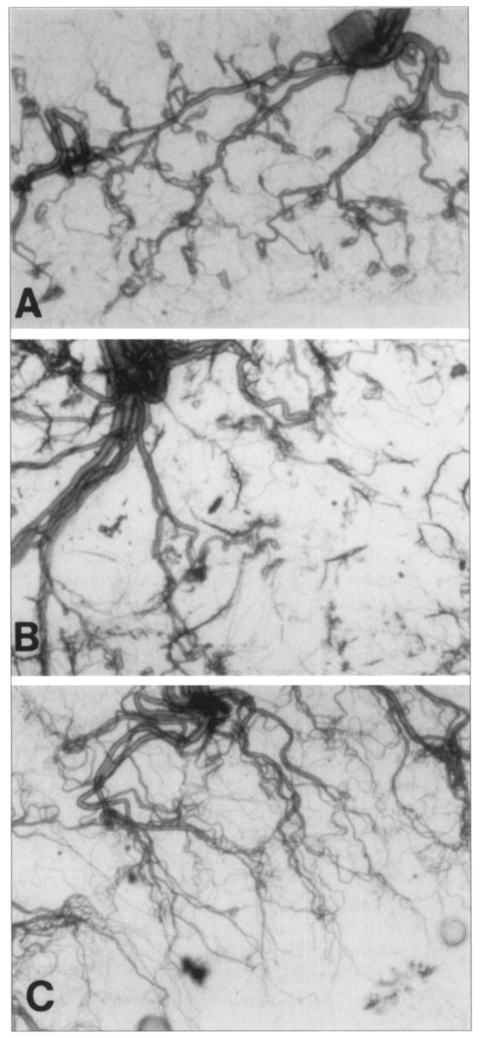INTRODUCTION
Malaria which was eradicated in Korea in 1979 re-emerged in 1993 and an outbreak occurred in northern part of Kyonggi-do, near the demilitarized zone, totaling 3,621 cases in 1999 (Ree, 2000; Lee et al., 2000). Therefore, epidemiological studies are urgently required for malaria control/eradication. Entomological approaches are important parameters in malaria epidemiology for understanding the dynamics of transmission of the infection. The longevity (the probability of daily survival) of the vector population is not only the key factor in the mathematical analysis of malaria transmission, such as the vectorial capacity, the net reproduction rate or the index of stability, but also important for assessment of the efficacy of the vector control measures (WHO, 1975; Gilles and Warrell, 1993).
The physiological age of vector mosquitoes can be determined from the structure of the ovaries. A technique for distinguishing between parous females (already having laid at least one batch of eggs) and nulliparous females (as yet have not oviposited) is the examination of the tracheoles of the ovaries of unfed females. Each ovary has two main tracheal trunks which are sub-divided into several branches and cover the ovary. In newly emerged females the fine tracheoles are closely wound at the terminal ends forming tight skeins (coiles). After the first blood meal and growth of the follicles, the coils of the terminal tracheoles stretch out and unwind. This process is irreversible and distinguishes the ovary of a parous female from that of a nulliparous one. This therefore permits an assessment of the nulliparous-to-parous ratio (Detinova, 1962). From knowledge of the proportion of parous females and the duration of the gonotrophic cycle, the probability of daily survival of mosquitoes can be calculated and their average longevity estimated (WHO, 1975).
This study objective is to compare the probability of daily survival of Anopheles sinensis, the vector mosquitoes of vivax malaria in malarious areas where an outbreake of malaria cases is occurring and non-malarious areas where malaria transmission has not been recently observed. The study was conducted in July-August of the malaria transmission season in 2000.
MATERIALS AND METHODS
Study areas
In malarious areas of Kyonggi-do, three locations were selected: Tongilchon, Paju-si; Jangpa-ri, Jindong-myon, Paju-shi; Donjung-ri, Wangjin-myon, Yonchon-gun. In non-malarious areas, the following three locations were selected: Juksan-ri, Gunsan-shi, Chollabuk-do; Sinchang-ri, Asan-shi, Chungchongnam-do; Taerak-ri, Jinchon-gun, Chungchongbuk-do.
Age determination
Anopheline mosquitoes resting on walls of a cowshed before and/or after feeding were collected using an aspirator and a torch. The mosquitoes were put into a cage (30×30×30 cm) giving sugar solution and kept in the laboratory until early next morning. The mosquitoes were anesthetized with chloroform and identified under a stereo-microscope. An. sinensis females were dissected for ovaries. The ovaries were dissolved in distilled water and dried on a slide, and the tracheoles covering the ovaries were observed for parity or nulliparity under a microscope (100×).
The probability of daily survival was calculated by the formula: the cube root of the proportion of parous females in the population sample, because the gonotrophic cycle takes place in 3 days in July-August in Korea (Ree et al., 2000).
RESULTS
Ovaries of the unfed, nulliparous females clearly showed tight skeins (coiles) of tracheoles (Fig. 1A), whereas those of the unfed, parous females showed completely stretched tracheoles (Fig. 1C). In case of the blood-fed, nulliparous females which were elapsed 10 hours after feeding, the coiles of tracheoles were considerably stretched from distal part. Nevertheless, the skeins were still clearly observed, though the size became smaller (Fig. 1B). Ovaries from the females elapsed more than 12 hours after feeding made it impossible to distinguish nulliparous/parous state. It is of importance to note that ovaries of even blood-fed mosquitoes were able to use for distinguishing the difference between nulliparity and parity, if the fed-females were not longer than 10 hours after feeding.
The result of ovary dissection is shown in Table 1. In malarious areas, total 915 females of An. sinensis from three different locations were dissected for ovaries and the parous rate was 64.6% in average (51.9-72.8%). In non-malarious areas, 758 females of An. sinensis from three different locations were dissected for ovaries, with 61.5% of the parous rate in average (52.6-64.9%). Total average of the parous rate in six locations was 61.5%. The probability of survival through one day was 0.864 and 0.850 in malaria endemic areas and non-malarious areas, respectively, which was not statistically different between two areas (p=0.79).
DISCUSSION
The parous rate of An. sinensis was 52.0% at Okku, Chollabuk-do in 1965, 76.7% at Yangpyong, Kyonggi-do in 1964, and 81.3% at Asan, Chungchongnam-do in 1965 (Paik et al., 1965). The parous rate (61.5%) obtained in this study was higher than that of Okku (plain area), but significantly lower than those of Yangpyong and Asan (hilly areas). In case of other Anopheles species, the probability of daily survival was 0.89 for An. pharoensis and 0.80 for An. multicolor in Egypt (Kenawy, 1991), 0.80-0.83 for An. pulcherrimus in Iran (Zaim et al., 1993), 0.88 for An. pseudopunctipennis in Southern Mexico (Fernandez-Salas et al., 1994), 0.80-0.88 for An. gambiae s.l. in Sudan (Constantini et al., 1996), and 0.45-0.68 for An. vestitipennis in southern Mexico (Arredondo-Jimenez et al., 1998).
The importance of the probability of daily survival of vectors for efficient transmission of infection is obvious. If the survival rate is less than 0.65 per day, then less than 1% of the females are likely to survive 10-12 days needed for completion of the sporogonic cycle of Plasmodium vivax (Gilles and Warrell, 1993). Mean temperature at Dongducheon, Kyonggi-do in July and August, 1999 was 24.9℃ (Korea Meteorological Administration, 1999), and duration of sporogonic cycle of P. vivax is 10 days at 25℃ (Detinova, 1962). Therefore, the probability of survival through 10 days was 0.232 in malarious areas and 0.161 in non-malarious areas, which means that 2.3% and 1.6% of the female mosquitoes respectively may live long enough to transmit malaria.







